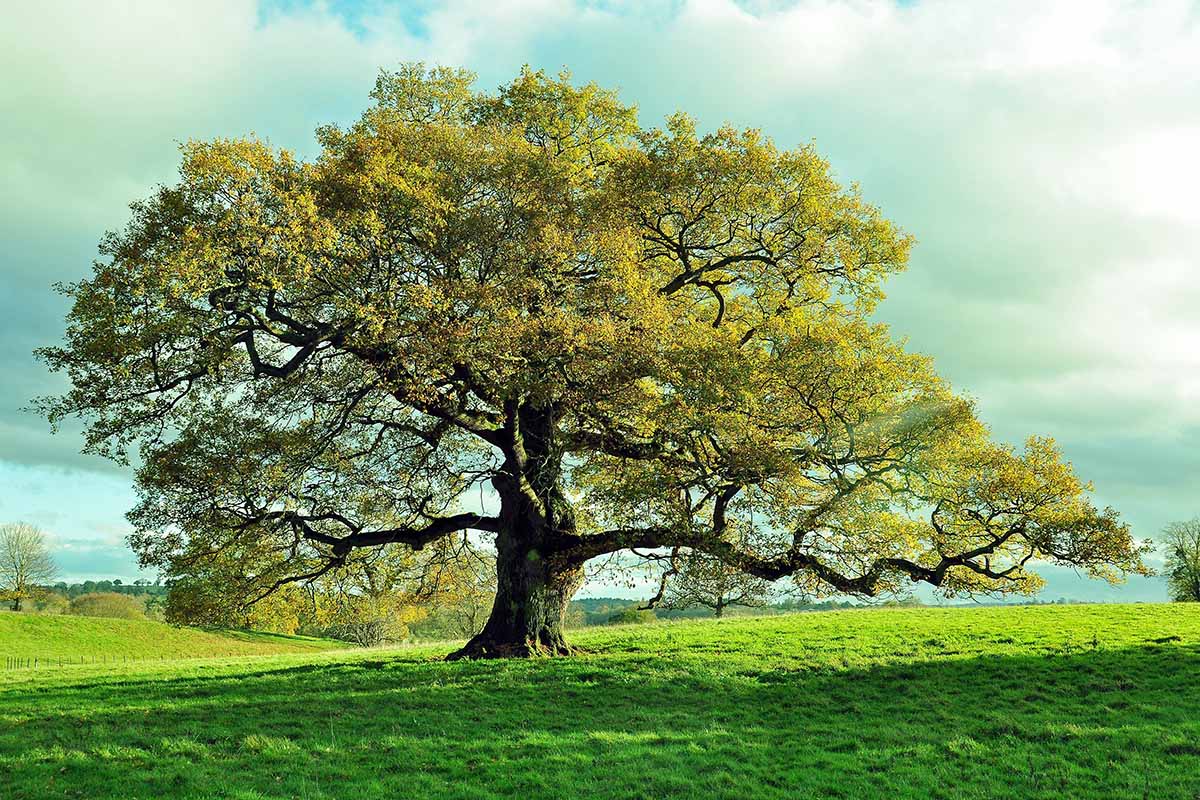Home>Gardening News and Trends>Latest News>How Does Spanish Moss Grow On Trees


Latest News
How Does Spanish Moss Grow On Trees
Published: November 12, 2023
Discover the fascinating process of how Spanish moss grows on trees. Stay updated with the latest news and findings on this unique plant phenomenon.
(Many of the links in this article redirect to a specific reviewed product. Your purchase of these products through affiliate links helps to generate commission for Chicagolandgardening.com, at no extra cost. Learn more)
Table of Contents
Introduction
Welcome to the fascinating world of Spanish Moss! This unique plant, known for its ethereal appearance and ability to gracefully drape trees, has captivated nature enthusiasts for centuries. With its delicate, silver-green strands swaying in the wind, Spanish Moss adds a touch of mystique to any landscape it graces.
Spanish Moss, scientifically known as Tillandsia usneoides, is not actually a moss but rather an epiphytic bromeliad. It is native to the southeastern United States, where it thrives in warm and humid climates. Spanish Moss can be found adorning a wide variety of trees, turning them into living tapestries suspended in mid-air.
Though its name may suggest a connection to Spain, Spanish Moss is not native to the Iberian Peninsula. The name is believed to have originated from the Spanish explorers who first encountered the plant in the Americas. They were reminded of the long, trailing beards that were commonly worn during that era.
In this article, we will explore the fascinating life cycle of Spanish Moss, the factors that promote its growth, its nutritional requirements, and the benefits and impacts it has on the trees it inhabits. Additionally, we will provide tips on caring for trees adorned with Spanish Moss to help you maintain the health and vitality of these beautiful natural wonders.
Now, let us delve into the enchanting world of Spanish Moss and uncover the secrets of its growth and interaction with trees.
What is Spanish Moss?
Spanish Moss (Tillandsia usneoides) is a unique and fascinating plant that is commonly found draping from tree branches in warm and humid regions. Despite its name, Spanish Moss is neither Spanish nor a true moss. Instead, it is an epiphytic bromeliad that belongs to the same family as pineapples.
Spanish Moss is characterized by its long, thin, and silver-gray strands that cascade from tree branches, creating a captivating and ethereal appearance. These delicate strands can grow up to 20 feet in length, creating a stunning visual display in the landscape.
As an epiphyte, Spanish Moss does not have roots that anchor it to the ground. Instead, it obtains moisture and nutrients from the air and rainfall. It uses its long, narrow leaves to absorb water and nutrients from the environment. The plant relies on the trees it inhabits for support, but it is not parasitic and does not extract nutrients from the host tree.
Spanish Moss is a resilient plant that can adapt to a wide range of environmental conditions. It is commonly found in southern states such as Florida, Louisiana, and Georgia, as well as in some areas of Central and South America. It prefers warm and humid climates but can tolerate drought and moderate cold temperatures.
While Spanish Moss is often associated with the Southern United States, it has also found its way into popular culture and art, symbolizing a sense of mystery and nostalgia. It has been featured in literature, poetry, and even in movies, adding a touch of enchantment to various creative works.
Now that we have a better understanding of what Spanish Moss is, let’s explore its intriguing life cycle and how it grows and attaches to trees.
Life Cycle of Spanish Moss
The life cycle of Spanish Moss is a fascinating process that allows it to reproduce and spread across its preferred habitat. This epiphytic bromeliad goes through several stages, from seed germination to the mature plant we associate with its iconic appearance.
The life cycle begins with the flowering stage. Spanish Moss produces small, inconspicuous flowers that are typically greenish-yellow in color. These flowers are pollinated by a variety of insects, such as bees and butterflies, that are attracted to the nectar within the flowers.
Once pollination occurs, the flowers develop into small capsules that contain numerous tiny seeds. These seeds are dispersed through various means, such as wind, rain, or the activity of animals and birds. The seeds are lightweight and equipped with fine hairs that allow them to be carried over long distances.
When one of these seeds lands on a suitable host tree, it begins to germinate. The seedling develops tiny, root-like structures known as rhizoids, which anchor the moss to the tree. Over time, the rhizoids grow and spread, providing stability for the developing plant.
As the Spanish Moss continues to grow, it produces long, slender leaves that hang gracefully from the branches. These leaves serve multiple purposes, including the absorption of moisture and nutrients from the air. They also contribute to the plant’s ability to photosynthesize and produce energy.
The growth of Spanish Moss is not limited to a specific season, as it can continue to expand and thrive throughout the year. This allows it to gradually cover large areas of a host tree, creating the iconic draped appearance that we often associate with Spanish Moss.
As the plant matures, it may produce additional side shoots that develop into separate colonies of Spanish Moss. This vegetative reproduction allows the plant to spread and colonize new areas, expanding its presence in the ecosystem.
The life cycle of Spanish Moss is a continuous process, with new seeds being dispersed, germinating, and growing into mature plants. This ensures the survival and proliferation of this captivating and unique epiphyte in its preferred habitat.
Now that we have explored the life cycle of Spanish Moss, let’s delve into the factors that contribute to its growth and abundance.
Factors that Promote Spanish Moss Growth
Spanish Moss, with its graceful draping tendrils, thrives in specific environmental conditions that contribute to its growth and abundance. Understanding these key factors can help us appreciate why it is commonly found in certain regions and how to create a suitable environment for its growth.
One of the primary factors that promote the growth of Spanish Moss is the presence of adequate moisture in the air. As an epiphytic plant, it relies on moisture from the atmosphere to absorb nutrients and water. Therefore, areas with high humidity levels, frequent rainfall, and proximity to bodies of water provide an ideal environment for Spanish Moss.
Furthermore, Spanish Moss prefers warm temperatures to thrive. It flourishes in regions with mild to hot climates, where the average temperature ranges between 70 to 95 degrees Fahrenheit (21 to 35 degrees Celsius). These warm temperatures facilitate the plant’s metabolism, allowing it to photosynthesize and grow efficiently.
The presence of suitable host trees is another crucial factor in promoting Spanish Moss growth. It tends to colonize certain tree species, including oak, cypress, pine, and bald cypress. These trees have rough bark and provide a favorable environment for the moss to attach and grow.
Another key factor is the availability of sunlight. While Spanish Moss can tolerate partial shade, it thrives in areas with ample sunlight exposure. Sunshine enables the plant to carry out photosynthesis, converting sunlight into energy for growth and development.
Spanish Moss growth can sometimes be inhibited by the presence of excessive air pollution or heavy metal contamination. These pollutants can interfere with the plant’s ability to absorb nutrients and may negatively impact its overall health and growth.
Additionally, disturbances such as hurricanes, strong winds, or human activity can disrupt Spanish Moss growth. Physical damage to the plant or its host tree can hinder its ability to thrive and may lead to a decline in population.
Overall, a combination of factors, including adequate moisture, warm temperatures, suitable host trees, sunlight exposure, and minimal pollution, play a significant role in promoting the growth and abundance of Spanish Moss in its natural habitat.
Now that we understand the factors that contribute to Spanish Moss growth, let’s explore how this delicate and fascinating plant attaches itself to trees.
How Spanish Moss Attaches to Trees
Spanish Moss has a remarkable ability to attach itself to trees, creating an enchanting draping effect that adds beauty to the landscape. Understanding how Spanish Moss achieves this attachment is key to appreciating its unique nature.
Contrary to popular belief, Spanish Moss does not obtain nutrients from its host tree. Instead, it uses the tree solely for support, relying on its own specialized structures to attach itself securely.
Spanish Moss attaches to trees primarily through its rhizoids, which are elongated root-like structures. Rhizoids develop from the germinating seed and grow in abundance as the plant matures. These structures have a fibrous and velcro-like texture, allowing them to intertwine and cling to the rough bark of trees.
The rhizoids of Spanish Moss not only provide physical support but also enable the plant to absorb moisture and nutrients from the air. They have the ability to capture and retain water droplets, ensuring a constant supply for the plant’s survival and growth.
Spanish Moss also takes advantage of the wind to aid in its attachment to trees. As the wind blows, it carries the free-floating seeds of Spanish Moss to new locations. When these seeds land on a suitable host tree, they germinate and begin the process of attachment.
Once established on a host tree, Spanish Moss grows and spreads by producing side shoots. These shoots elongate and cascade down from the parent plant, gradually covering larger areas of the tree. If left undisturbed, Spanish Moss can eventually create a stunning canopy that envelops the branches and limbs.
It is important to note that Spanish Moss does not harm its host tree. It does not derive nutrition from the tree or parasitize it in any way. Instead, it simply uses the tree as a platform for support and access to sunlight and moisture.
Due to its adaptability and the specialized structures that enable attachment, Spanish Moss can be found not only on trees but also on other structures such as fences, power lines, and even man-made structures like buildings.
Now that we have explored how Spanish Moss attaches itself to trees, let’s uncover its nutritional requirements and how it sustains its growth.
Nutritional Requirements of Spanish Moss
Despite its delicate appearance, Spanish Moss (Tillandsia usneoides) is a resilient and adaptable plant that can thrive in various environments. As an epiphytic bromeliad, Spanish Moss obtains its nutrients from the air and rainfall, as opposed to deriving them from the host tree it attaches to.
Spanish Moss absorbs nutrients primarily through its long, slender leaves. These leaves are covered in specialized scales called trichomes, which allow the plant to capture moisture and nutrients from the surrounding environment. The trichomes also help to prevent excessive water loss and protect the plant from drying out.
One of the primary nutrients that Spanish Moss requires is water. It relies on rain and humidity to provide the necessary moisture for its survival. The plant’s ability to absorb and retain water from the atmosphere is crucial in sustaining its growth and vitality.
Spanish Moss also obtains nutrients such as nitrogen, potassium, and phosphorus from the air. These nutrients are present in particles and dust that settle on the plant’s leaves. The trichomes on the leaves capture these particles, allowing the plant to extract the needed nutrients.
In addition to water and nutrients obtained from the air, Spanish Moss benefits from the natural processes that occur in its environment. For example, decaying organic matter, such as fallen leaves and plant debris, can provide additional nutrients to the plant when they become trapped within the moss.
While Spanish Moss can survive in nutrient-poor environments, it may benefit from supplemental nutrition in certain circumstances. Fertilization with a balanced, water-soluble fertilizer formulated for epiphytic plants can help provide additional nutrients and support healthy growth.
It is important to note that excessive fertilization or the use of fertilizer with high nitrogen content can lead to overgrowth and impact the balance of the ecosystem. Therefore, it is advisable to follow recommended guidelines and use fertilizers sparingly, if at all.
Overall, Spanish Moss’s nutritional requirements are relatively modest, with a reliance on water, atmospheric nutrients, and the natural processes of its environment. This adaptability to low-nutrient conditions contributes to its ability to thrive in various habitats and adds to its allure as a captivating epiphytic plant.
Now that we understand the nutritional requirements of Spanish Moss, let’s explore the benefits it provides to trees and the ecosystem.
Benefits of Spanish Moss on Trees
Spanish Moss (Tillandsia usneoides) not only adds aesthetic beauty to trees, but it also provides several benefits to the trees and the ecosystem as a whole. Let’s explore some of the advantages of having Spanish Moss adorning trees.
One of the key benefits of Spanish Moss is its ability to create a microclimate around the tree. The presence of Spanish Moss helps to regulate temperature and humidity levels by trapping moisture and creating a barrier against excessive sunlight. This can be especially beneficial in hot and arid environments, where the moss acts as a natural air purifier and reduces water loss through evaporation.
Spanish Moss also serves as a protective layer for the tree bark. The long strands of Spanish Moss help shield the tree from extreme weather conditions, such as intense sunlight, heavy rainfall, and strong winds. This protective layer can help prevent the bark from drying out and protect it from physical damage caused by falling debris or hailstorms.
Additionally, Spanish Moss provides nesting material and habitat for a variety of wildlife. Birds, such as the Northern Parula and the Hooded Warbler, often incorporate Spanish Moss into their nests, using it as a soft lining or camouflage. The moss also offers shelter to insects, spiders, and small mammals, enhancing the overall biodiversity of the area.
Spanish Moss acts as a natural filter for air pollutants. Its specialized structures, including the trichomes on its leaves, can trap dust, pollutants, and airborne particles, improving the air quality in its immediate vicinity. This can be particularly beneficial in urban areas where air pollution is a concern.
Furthermore, Spanish Moss plays a role in nutrient cycling within the ecosystem. As it captures and accumulates organic matter, such as fallen leaves and plant debris, the moss slowly decomposes these materials. This decomposition process releases essential nutrients back into the environment, contributing to the overall fertility of the ecosystem.
Spanish Moss’s presence on trees can also provide camouflage and protection for small animals. It can help obscure the visibility of vulnerable creatures, such as tree frogs or insect prey, from predators that rely on visual hunting strategies.
With its wide range of ecological benefits, Spanish Moss adds to the overall health and diversity of the ecosystem it inhabits. It serves as a fascinating example of how a seemingly delicate plant can contribute to the resilience and functioning of the natural world.
Now that we have explored the benefits that Spanish Moss provides to trees and the ecosystem, let’s examine the potential impacts it may have on its host trees.
Impacts of Spanish Moss on Trees
While Spanish Moss (Tillandsia usneoides) is generally benign and does not harm its host trees, there are some potential impacts that should be considered. Understanding these impacts can help ensure the long-term health and vitality of both the moss and the trees it inhabits.
One potential impact of Spanish Moss is its potential to shade out leaves or branches of the host tree. In dense populations, Spanish Moss can block sunlight from reaching the lower branches, potentially reducing their photosynthetic capacity. This shading effect can impact the overall growth and vigor of the affected branches, although it is usually not detrimental to the tree’s survival.
Another consideration is the potential for Spanish Moss to accumulate moisture against the tree bark. This can create a damp environment that promotes the growth of other organisms, such as fungi or bacteria. While this can occasionally lead to localized decay or rot, it is not typically a significant concern for healthy trees with intact bark.
In rare cases, an excessive amount of Spanish Moss can accumulate on weakened or stressed trees, potentially adding additional weight to the branches. This added weight, combined with factors such as strong winds or storms, may increase the risk of branch breakage. However, healthy and structurally sound trees are generally resilient enough to support the weight of the moss without significant issues.
It’s important to note that Spanish Moss is not truly parasitic and does not harm the tree by extracting nutrients. While it may compete with the host tree for sunlight and moisture, it typically does not cause significant damage when growing in its natural habitats.
However, if Spanish Moss becomes overly abundant or forms dense mats on the tree, it may impede the tree’s ability to capture sunlight or hinder the growth of new branches. Monitoring the density of Spanish Moss on the tree and pruning it back when necessary can help prevent these potential impacts and ensure the continued health of the host tree.
Overall, the impacts of Spanish Moss on trees are generally minimal and do not pose significant threats to the long-term health and survival of the host trees. With proper care and maintenance, trees can coexist harmoniously with this captivating, epiphytic bromeliad.
Now that we have explored the potential impacts of Spanish Moss on trees, let’s discuss how to care for trees that have Spanish Moss.
How to Care for Trees with Spanish Moss
Caring for trees with Spanish Moss involves maintaining the health and vitality of both the host tree and the beautiful epiphytic bromeliad. While Spanish Moss does not directly harm its host tree, certain care practices can help ensure the coexistence of both organisms. Here are some guidelines to care for trees with Spanish Moss:
Regular Inspections: Regularly inspect the tree and the Spanish Moss growing on it. Look for signs of stress or disease in the tree, such as dead or dying branches, and address any issues promptly. Check for any excessive accumulation of Spanish Moss that could potentially shade out branches or impede sunlight penetration.
Pruning: If Spanish Moss becomes overly thick and abundant, consider selectively pruning it to reduce its density. Remove sections of the moss, focusing on areas where it may be shading out branches or inhibiting new growth. Be careful not to damage the host tree during this process.
Provide Adequate Sunlight: Because Spanish Moss relies on sunlight for photosynthesis, ensuring adequate sunlight exposure for the host tree is essential. Avoid planting or maintaining trees in overly shaded areas where Spanish Moss growth may be excessive. Additionally, thin out branches or foliage to increase sunlight penetration, if needed.
Monitor Moisture Levels: While Spanish Moss benefits from moisture, it is crucial to ensure proper drainage around the tree. Excessive moisture accumulation against the bark can provide a breeding ground for fungi or bacteria. Manage irrigation and ensure proper drainage to prevent long-term moisture-related issues.
Fertilization: In most cases, Spanish Moss does not require fertilizer, as it derives its nutrients from the air. However, if the host tree demonstrates signs of nutrient deficiency, consider using a slow-release, low-nitrogen fertilizer specifically formulated for trees in the surrounding soil. Follow the appropriate application guidelines to avoid over-fertilization.
Promote Tree Health: A healthy host tree is more likely to coexist harmoniously with Spanish Moss. Practice proper tree care techniques, such as regular watering, mulching, and pruning, to ensure the tree’s vitality. Consult with an arborist for guidance specific to the tree species and local climate conditions.
Be Mindful of Wildlife: Remember that Spanish Moss provides habitat and nesting material for various wildlife species. When trimming or pruning the moss, take care to preserve any active nests or habitats, allowing these creatures to thrive alongside the moss and the tree.
Caring for trees with Spanish Moss involves striking a balance between maintaining the health of the host tree and appreciating the aesthetic beauty of the moss. By following these care practices, you can ensure the long-term coexistence of both organisms, creating a harmonious and captivating natural environment.
Now that we have explored how to care for trees with Spanish Moss, let’s summarize the key points we have discussed.
Conclusion
Spanish Moss, with its ethereal beauty and graceful draping, adds a touch of mystery and enchantment to the landscape. Despite its name, this epiphytic bromeliad is not Spanish nor a true moss. It thrives in warm, humid climates and attaches itself to trees, creating a captivating display that showcases the wonders of nature.
In this article, we have explored various aspects of Spanish Moss, from its life cycle and growth patterns to its nutritional requirements and benefits on trees and the ecosystem. We have also discussed the potential impacts of Spanish Moss on host trees and provided guidelines for caring for trees adorned with this captivating plant.
Spanish Moss’s ability to attach to trees, absorb nutrients from the air, and create a microclimate has multiple benefits. It provides protection for the tree’s bark, enhances the biodiversity of the area, contributes to air purification, and plays a role in nutrient cycling within the ecosystem. Furthermore, Spanish Moss serves as a source of inspiration and fascination in literature, art, and popular culture.
While Spanish Moss generally doesn’t harm its host tree, certain considerations should be taken into account for proper care and maintenance. Regular inspections, selective pruning, ensuring adequate sunlight and proper drainage, and promoting tree health are essential in maintaining the coexistence of Spanish Moss and trees.
By understanding the intricate relationship between Spanish Moss and trees, we can appreciate the delicate balance of nature and the interconnectedness of different organisms in the environment.
So, next time you encounter the mesmerizing presence of Spanish Moss adorning a tree, take a moment to admire its beauty and reflect on the symbiotic relationship it shares with its host tree. The delicate strands of Spanish Moss serve as a reminder of the resilience and adaptability of nature, creating a captivating sight that continues to inspire and fascinate us.





